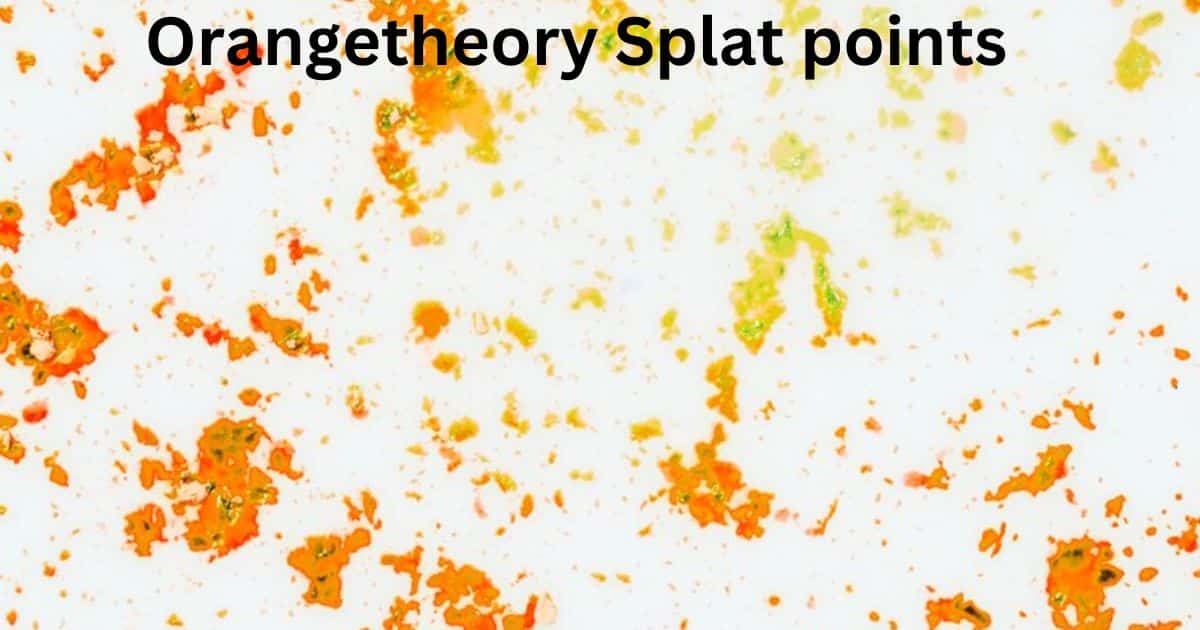Orangetheory is a famous fitness studio that offers high-intensity interval training workouts. During an Orangetheory class, you wear a heart rate monitor that tracks how hard you are working.
The goal is to spend time in the Orange Zone, which means your heart rate is at 84% or higher than your maximum heart rate. When you are in this high effort zone, you earn OrangetheorySplat Points. Splat is short for seconds of physical labor at the target rate.
The more Splat Points you earn during the workout, the more calories you will burn overall. Getting 12 or more Splat Points is considered a great workout at Orangetheory.
What are Orangetheory Splat points used for?
Orangetheory Splat points are used to measure how hard you worked during an Orangetheory Fitness workout class. The Splat points show how many minutes you spent with your heart rate at 84% or higher of your maximum heart rate. This high heart rate zone burns a lot of calories and fat.
The more Splat points you earn, the more intense and effective your workout is at burning calories and improving your fitness. Orangetheory recommends trying to get at least 12 Splat points per workout to see the best results.
The Splat points help motivate you during the class to keep pushing yourself to work harder. They also allow you to track your effort over time to make sure you are consistently challenging yourself. Many Orangetheory members aim for a certain number of Splat points as their workout goal.
What are the heart rate zones in Orangetheory?
In an Orangetheory workout, your heart rate is tracked and divided into different colored zones. These zones show how hard you are working based on your heart rate. The green zone is a warm-up zone, where your heart rate is under 84% of your maximum heart rate. This is a lighter effort level.
The orange zone is between 84-91% of your maximum heart rate. This is the ideal calorie-burning and fat-burning zone that Orangetheory aims for. The red zone is 92% or higher of your maximum heart rate. This is an all-out effort that is very challenging to sustain for long periods.
How do I record the splat points?
At Orangetheory, you wear a heart rate monitor during the workout. This monitor tracks your heart rate and displays it on the studio’s screens using different color codes. As you exercise, pay attention to the colored zones that show up next to your name on the screen. The orange and red zones indicate you are earning Splat Points.
You get one Splat Point for every minute your heart rate is in the orange or red zones. So if you spent 15 minutes total in those zones, you earned 15 Splat. You don’t have to record anything yourself manually. The heart rate monitors automatically track your Splat Points earned.
How do I check my splat points during the class?
For the Orangetheory workout, there are large screens around the studio that display everyone’s name and real-time heart rate data. Look for your name on the screen. Next to your name, you’ll see your current heart rate number and a colored box or bar.
The color of the box shows which heart rate zone you are currently in based on your maximum rate. Green means you’re in the warm-up zone, orange means you’re in the ideal calorie-burning zone, and red means you’re in the all-out effort zone.
What is a good splat point in Orangetheory?
To Orangetheory, earning 12 or more Splat points during a single workout class is considered a good and effective score. Splat points measure how many minutes you spent with your heart rate at 84% or higher of your maximum heart rate. This high zone burns a lot of calories and fat.
Orangetheory’s workouts are designed to have you alternate between pushing yourself hard to earn Splat points and then having active recovery periods. So, hitting 12 Splats shows you followed that high-intensity interval pattern well.
The Splat Point system provides a tangible way to measure your effort. As you get fitter over time, you may need to aim for higher Splat targets. But in general, 12 or more points indicate you accumulated an excellent period of high effort to maximize calorie burn and metabolic training benefits from that Orangetheory session.

How many splat points are too much?
Orangetheory recommends aiming for at least 12 Splat points per workout, there can also be too many Splat points. More than 25-30 Splat in a single session is generally considered excessive.
Splat points measure the total minutes you spend with your heart rate at 84% or higher of your maximum rate. Too many Splat points mean you spent an excessive amount of time pushing at an all-out, unsustainable effort level.
The Orangetheory workouts are designed with intervals that have you spiking your heart rate into the Red zones, followed by active recovery periods to bring it back down. This interval pattern is better for calorie burn than staying maxed out the entire time.
You might want to check: Catch me if you can Orangetheory Workout- All you need to know about
How many splat points do I need to lose weight?
There is no exact number of Splat points required to lose weight, as it depends on several factors. However, aiming for 12-20 points per Orangetheory workout is a good target range for weight loss.
Splat points measure the total minutes you spend working out with your heart rate at 84% or higher of your maximum rate. The more Splat, the more calories you burn during and after the workout.
Orangetheory recommends trying to get at least 12 Splat per class. This indicates you spent sufficient time working at a high intensity to maximize calorie burn and kick-start your metabolism.
Are high splat points bad?
Splat points measure how many minutes you spend with your heart rate at 84% or higher of your maximum heart rate during an Orangetheory class. While earning at least 12 Splat points is considered a good effective calorie-burning workout, going much beyond 25-30 Splat points is likely too high.
When you accumulate an excessive number of Splat points, it means you spent a very long period pushing at an all-out, maximal effort without sufficient recovery periods. This can put unnecessary strain on your body and increase the risks of overtraining, injury, dizziness, or burnout.
While getting into the Orange and Red zones is good, spending the entire class maxed out is unwise and unsafe. Your muscles need those easier intervals to flush out lactic acid. Most members and coaches recommend aiming for 12-20 Splat points as a challenging but sensible target range per class.
Benefits of Splat points
Boosted Stamina
Earning Splat points means spending time working out at a high-intensity level near your maximum heart rate. This challenges your cardiovascular system and builds better endurance and stamina over time. The more you exercise in those tough orange and red zones, the more your body adapts and your stamina improves.
Increase Post-Exercise Oxygen Consumption
When you accumulate a lot of Splat by exercising vigorously, your body has to work harder to recover and return to its rested state. This increases your post-exercise oxygen consumption for hours after the workout, which means you burn more calories even after leaving the gym. More Splats leads to greater excess post-exercise calorie burn.
Maximize Heart Rate
The whole point of Splat points is pushing your heart rate up into the target orange and red zones that are 84% or more of your maximum heart rate. Spending time in these elevated zones provides a better cardiovascular workout compared to lower intensities.
Why do I have no splat points?
Splat points usually mean you did not work hard enough to get your heart rate up into the target orange and red zones during the class.
Splat are awarded for each minute you spend with your heart rate at 84% or higher of your maximum heart rate. This elevated heart rate zone is where you burn the maximum calories and fat.
There could be a few reasons for this:
- Your maximum heart rate is set incorrectly in the system. If it’s set too high, the Splat zones are harder to reach.
- Equipment issues with your heart rate monitor prevented accurate tracking of your elevated heart rates.
- You are very new to high-intensity exercise, so your fitness level makes it extremely difficult currently to get into the Splat zones.

Frequently Asked Question
What are Splat points at Orangetheory Fitness?
Splat are a measure used in Orangetheory Fitness classes to track the time spent in the heart rate Orange Zone or Red Zone, which are zones of elevated heart rate intensity.
Why are Splat points important?
Splat points are important because they indicate the time spent working at a high enough intensity to achieve an afterburn effect, where your body continues to burn calories at an elevated rate even after the workout is over.
How do I earn Splat points?
You earn Splat points by keeping your heart rate elevated into the Orange Zone (84-91% of your maximum heart rate) or the Red Zone (92-100% of your maximum heart rate) during the treadmill, rowing, and floor portions of an Orangetheory class.
How are Splat points tracked?
Points are tracked using a heart rate monitor that you wear during the class. The monitor connects to the Orangetheory system, which displays your real-time heart rate and Splat point accumulation on the studio’s screens.
Can I see my Splat point history?
Yes, Orangetheory members can access their Splat point history and other workout data through the Orangetheory app or website.
Final Thoughts
Orangetheory utilizes the Splat system as a motivational tool and metric to ensure members are working at an intense enough level to maximize the benefits of the high-intensity interval training workouts. Splat provide real-time feedback on effort by tracking heart rate zones, allowing people to see exactly how many minutes they spent in the calorie-burning sweet spot.
This gamifies the experience and allows progress to be tracked over time. While moderate Splat point scores around 12-20 are ideal, the points incentivize members to push hard enough to elevate heart rate but not overly exert themselves into potentially unsafe zones.

With over 10 years of experience working in the fashion industry, I bring a unique expertise to my role. I am looking forward to sharing my knowledge and insights on the latest trends with my readers.











